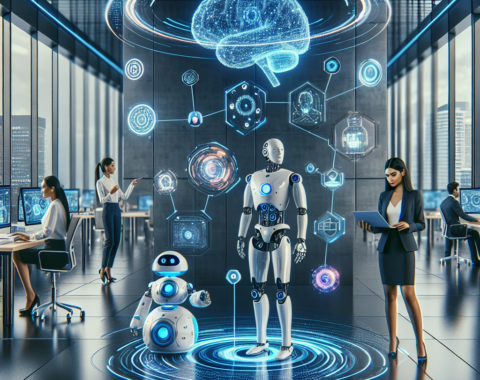
Revolutionary AI-Quantum Technology Enables Tactile Perception for Machines
The fusion of Artificial Intelligence (AI) and quantum computing has ushered in an era of unprecedented technological breakthroughs. Among these, the latest development in **AI-Quantum integration** allows machines to perceive textures through tactile sensing, an ability previously exclusive to living beings.
Understanding the Union of AI and Quantum Computing
Before delving into how this novel technology provides machines with a sense of touch, it is essential to understand the synergy between AI and quantum computing:
- Artificial Intelligence: AI is the simulation of human intelligence processes by machines, especially computer systems. These processes include learning, reasoning, and self-correction.
- Quantum Computing: Quantum computing uses principles from quantum theory to solve complex computations significantly faster than traditional computers, leveraging quantum bits, or qubits, that can represent and store information in numerous states simultaneously.
When combined, AI algorithms benefit from the massive computational power of quantum processors. This union fuels more sophisticated machine learning algorithms, allowing for new capabilities and revolutionary applications.
The Innovation: AI-Quantum Tactile Perception
The Concept Behind Tactile AI
Broadening the horizon of AI applications, scientists and researchers have developed a framework where AI can mimic human-like touch perception by using quantum properties.
- Quantum Touch Sensors: Devices equipped with these sensors can now gather, process, and interpret texture data. Unlike traditional sensors, quantum touch sensors identify surface irregularities at a microscopic level, offering unparalleled precision.
- Adaptive Learning: With the enhanced capacity to process data from quantum-powered sensors, AI models can adaptively learn about different textures, much like human sensory learning through experience.
Transformative Applications
The implications of AI’s tactile capacity are vast, spanning various industries and reshaping existing paradigms:
- Manufacturing: AI-powered robots can ensure quality control by feeling materials for defects, providing more reliable manufacturing processes.
- Healthcare: Robots could assist surgeries by recognizing tissue characteristics, improving precision in medical procedures.
- Robotics: Humanoid robots with tactile abilities could perform tasks requiring delicate touch, like handling fragile objects.
- Consumer Electronics: Smart devices with tactile feedback can deliver enhanced user experiences and intuitive user interactions.
Challenges and Considerations
Despite the promise this technology holds, there are several challenges and considerations:
- Complexity of Integration: Merging AI with quantum computing is a complex task, requiring sophisticated hardware and software solutions, which could pose a significant barrier to widespread implementation.
- Quantum Decoherence: Maintaining coherence in quantum states is a major hurdle. Ensuring stable and reliable performance of quantum sensors and processors is vital.
- Cost Factor: The production and maintenance costs of AI-quantum systems could be high, limiting accessibility to a select few industries at the initial stages.
Ethical and Social Considerations
As with any disruptive technology, ethical considerations need to be at the forefront. Here are some aspects to keep in mind:
- Privacy Concerns: With AI becoming more capable of intricate interactions, ensuring data privacy and security becomes crucial.
- Employment Impact: As machines become more capable, there may be concerns about job displacement across different sectors.
- AI Autonomy: The end goal of AI research often involves autonomous decision-making, raising discussions about moral and ethical governance of machine actions.
The Future of AI-Quantum Tactile Technology
As the journey of AI-Quantum technology progresses, the field is set to expand into new and innovative applications. We are likely to witness:
- Refinements in Sensor Technology: Continuous research may vastly improve sensor techniques, making tactile machines more perceptive.
- Wider Industrial Adoption: As costs drop and integration techniques mature, we can expect broader implementation across various industry verticals.
- Innovative Products: New, smarter, tactile-aware consumer products could revolutionize everyday living by seamlessly integrating with human activities.
While this new frontier presents numerous opportunities, constant evaluation and adaptation to the evolving ecosystem will be essential.
Conclusion
The marriage of AI and quantum technology opens new dimensions in machine learning and robot capabilities, specifically enhancing tactile perception. Although challenges remain, the potential benefits suggest transformative impacts across diverse sectors. By responsibly managing hurdles and implications, society stands on the brink of another technological revolution – one led by machines endowed with the power of touch.




